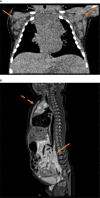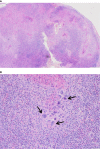Case Report: Symptomatic Chronic Granulomatous Disease in the Newborn
- PMID: 33854515
- PMCID: PMC8039294
- DOI: 10.3389/fimmu.2021.663883
Case Report: Symptomatic Chronic Granulomatous Disease in the Newborn
Abstract
Chronic granulomatous disease (CGD) is a primary immunodeficiency, which is diagnosed in most patients between one and three years of age. Here we report on a boy who presented at birth with extensive skin lesions and lymphadenopathy which were caused by CGD. An analysis of the literature revealed 24 patients with CGD who became symptomatic during the first six weeks of life. Although pulmonary complications and skin lesions due to infection were the leading symptoms, clinical features were extremely heterogenous. As follow-up was not well specified in most patients, the long-term prognosis of children with very early onset of CGD remains unknown.
Keywords: chronic granulomatous disease; early onset; neonate; outcome; symptoms.
Copyright © 2021 Miladinovic, Wittekindt, Fischer, Gradhand, Kunzmann, Zimmermann, Bakhtiar, Klingebiel, Schlösser and Lehrnbecher.
Conflict of interest statement
The authors declare that the research was conducted in the absence of any commercial or financial relationships that could be construed as a potential conflict of interest.
Figures



References
Publication types
MeSH terms
Substances
LinkOut - more resources
Full Text Sources
Other Literature Sources
Research Materials

